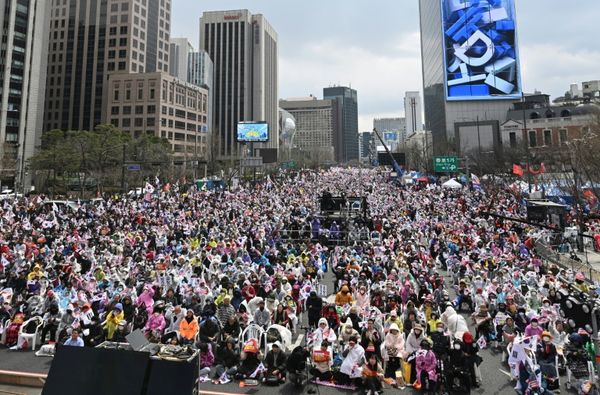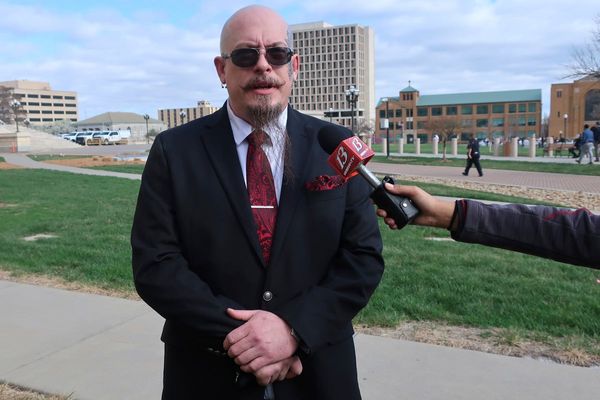Robert L. Santos did not get to shoot concerts at the South by Southwest festival this year because, as the new Census Bureau director, “I have a day job now.”
A former vice president at the Urban Institute and past president of the American Statistical Association, Santos now leads the agency producing data that guides more than $1.5 trillion in federal spending annually. He also spent years honing his skills as a photographer, working his way up to crew chief at the annual SXSW festival in Austin.
President Joe Biden’s pick to lead the Census Bureau through 2026, Santos is the first person of color to head the agency permanently. Two months after Santos took over the role, the agency released a report showing the 2020 census missed almost one in 20 Latinos nationwide. It also overcounted the white and Asian populations.
Santos and others said the agency faced “unprecedented” challenges trying to conduct the count amid the coronavirus pandemic. They noted the Census Bureau said the count missed about 0.25% of the American population.
At a recent scientific advisory committee meeting, Santos pitched a “transformational” change to agency operations as it gets ready for the 2030 census: Over the next few years, he wants to take apart some of the silos the agency has built between the dozens of different data products it produces for other agencies.
The Biden administration also pitched a new way to fund the census process as part of budget documents released Monday, combining normally separate census funds into a single program.
CQ Roll call recently interviewed Santos. What follows is an edited portion of the conversation.
Q. You’re about three months into the job. We’ve talked before about your passion for event photography. Were you able to go to the SXSW festival this year? What was it like?
A. I actually visited the SXSW photo crew headquarters and got a bunch of selfies with some of my former crew. Because I’m a manager type, I ended up becoming a photo crew chief. And so for the last four years or so, I was working on selecting and mentoring many of the photographers there.
It was like going back home to family. It’s such an intense experience for two weeks. You’re working day and night with these folks. Many of whom are these very passionate photographers that can barely make ends meet, who are incredibly creative and innovative. You form these bonds that remain over time.
I went back and kind of walked into the headquarters and it was like old times. It was nice seeing everybody, but I didn’t have the opportunity to attend the South by Southwest festival itself. Because I have a day job now.
Q. How different is running the Census Bureau from organizations like the American Statistical Association or being at the Urban Institute?
A. It’s been enormously enlightening and very different. It is different in a very good way. First of all, it’s an absolute honor to be a part of this great team and to be in a position where I can serve my country. I arrived at the Bureau with absolutely no expectation on how I would be received, and to my delight the career staff have been welcoming and they’ve been helpful. They’ve been very professional.
It’s been exciting and energizing for me because my two biggest passions in the world are helping people and statistics. And the Census Bureau in a leadership position is a place where I believe that I can help the most in this area. And what I’m trying to do here is essentially create an atmosphere for more excellence.
I’ve used the first couple of months as a learning opportunity, and wonderful career staff at the Census Bureau have been providing me with many opportunities to learn the depth and breadth of their entire operation — or our entire operation, I should say. I’m busy learning and getting ready to do my thing in terms of allowing and enabling them to do a better job and in imparting my vision on how we can achieve excellence.
Q. You spent a lot of your time at your prior roles examining and critiquing census operations. What’s different now that you are inside?
A. My most insightful moment was learning more about the 2020 census operation. As an outside policy researcher and statistician, I spent a lot of time going over the 2020 census operational plan, specifically the (non-response followup) for when people didn’t submit their forms. That’s really where my expertise lies.
What I found was that, despite the pandemic, the career staff at the Census Bureau and the field operations folks were able to turn on a dime and adapt to whatever situation arose. Be it a shutdown, because of the pandemic or natural disasters like wildfires or hurricanes or any other type of event, and still persevere and complete the job that they started out to do. What I hadn’t realized was that there were a large number of alternative plans that were tailored to specific situations and communities.
Q. The report issued by your agency in March showed the agency disproportionately missed people in the Black and Hispanic or Latino populations. Many advocates attributed those undercounts to decisions made by the prior administration.
What should the Census Bureau say to build up trust again in communities that might have been scared off by the attempted addition of the citizenship question or attempt to exclude undocumented immigrants from apportionment?
A. There there have always been segments of the population, not just undocumented immigrants, that have a resistance to participation because of lack of trust in the government. And certainly that was the case on steroids this time around.
We were prepared to deal with that, which is why we had a really large number of community partners and worked with them, as well with as with a large stakeholder community, to engage in different ways to help impart a trust message and to promote more accessibility when we went to knock on doors, or more accessibility in terms of identifying a mail form.
Having said that, at the end of the day, we were in a pandemic. It was unprecedented. People were suffering. Households didn’t know whether they could pay the medical bills. Folks didn’t have jobs and didn’t know where their next meal was coming from. Utilities needed to be paid. Some folks thought they were going to get thrown out despite the freeze on landlords to evict. It’s understandable that there would be communities (like that) and we all know that communities of color were the most affected.
Q. You’ve talked up an effort to modernize the Census Bureau and its process. What will that look like for people outside the agency? Will it mean a cheaper census, or more databases?
A. It certainly means more access to data, better data and perhaps new data that we hadn’t necessarily collected in the past. The issue of whether it’s less expensive or not is yet to be determined. That is certainly our aspiration — to become more efficient. And we shall see where that transformation takes us.
The transformation process is a truly enterprise level area. We do over 100 different surveys. And we do that as well as a decennial census, which is a huge effort. We’re looking — rather than try to implement them as individually tailored systems — to create a single enterprise that involves bringing data into a single system. Then allowing it to generate statistics most relevant to whatever issues we are dealing with at the time.
So that’s the vision, to have a single system that brings in data, processes it and then exports it so that it provides answers to questions about who we are as a population for portrait purposes.
This ultimately is a much more efficient operation, so we expect there to be some cost savings. There needs to be some investment upfront. But we think it is the path to the future to combine different data sources, including sources of administrative data to create more relevant and timely data products and hopefully, we expect, at a less expensive cost.
Q. You mentioned the Census Bureau may include outside data sources as part of the modernization effort. Advocates argue many marginalized groups are not represented in the other data sources out there, such as government administrative records and commercial data. How do you intend to deal with that problem?
A. That’s an excellent question. Thank you for asking that. We could most likely account for an overwhelming majority — maybe 70, 80 or 90 percent of the population — with less expensive data collection methods, a combination of a reduced form and administrative data of some sort, or a method yet to be developed.
But the idea is that we can relatively inexpensively count with current administrative data that’s relatively high quality for a huge chunk of the population. It not only reduces the expense, but creates savings that can then be used to go after and solicit information from the much harder-to-count communities.
Part of the reason there are undercounts is that for the communities that are historically hard to count we have limited resources to put out there. (With this) we can leverage other types of data to count the folks that are easy to count, create savings and then focus those on the harder to count communities. So that we can arrive at an overall smaller undercount or possibly no undercount at all.
___







